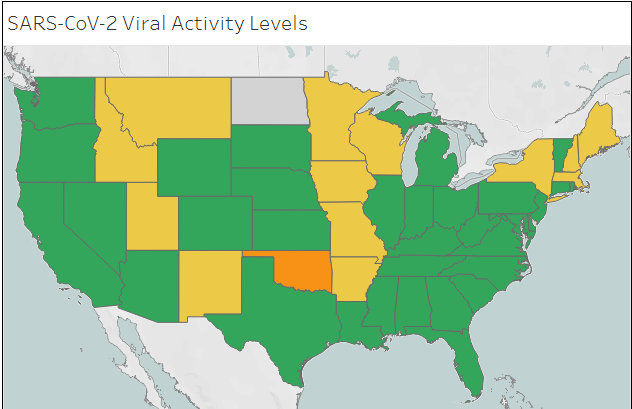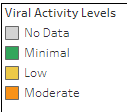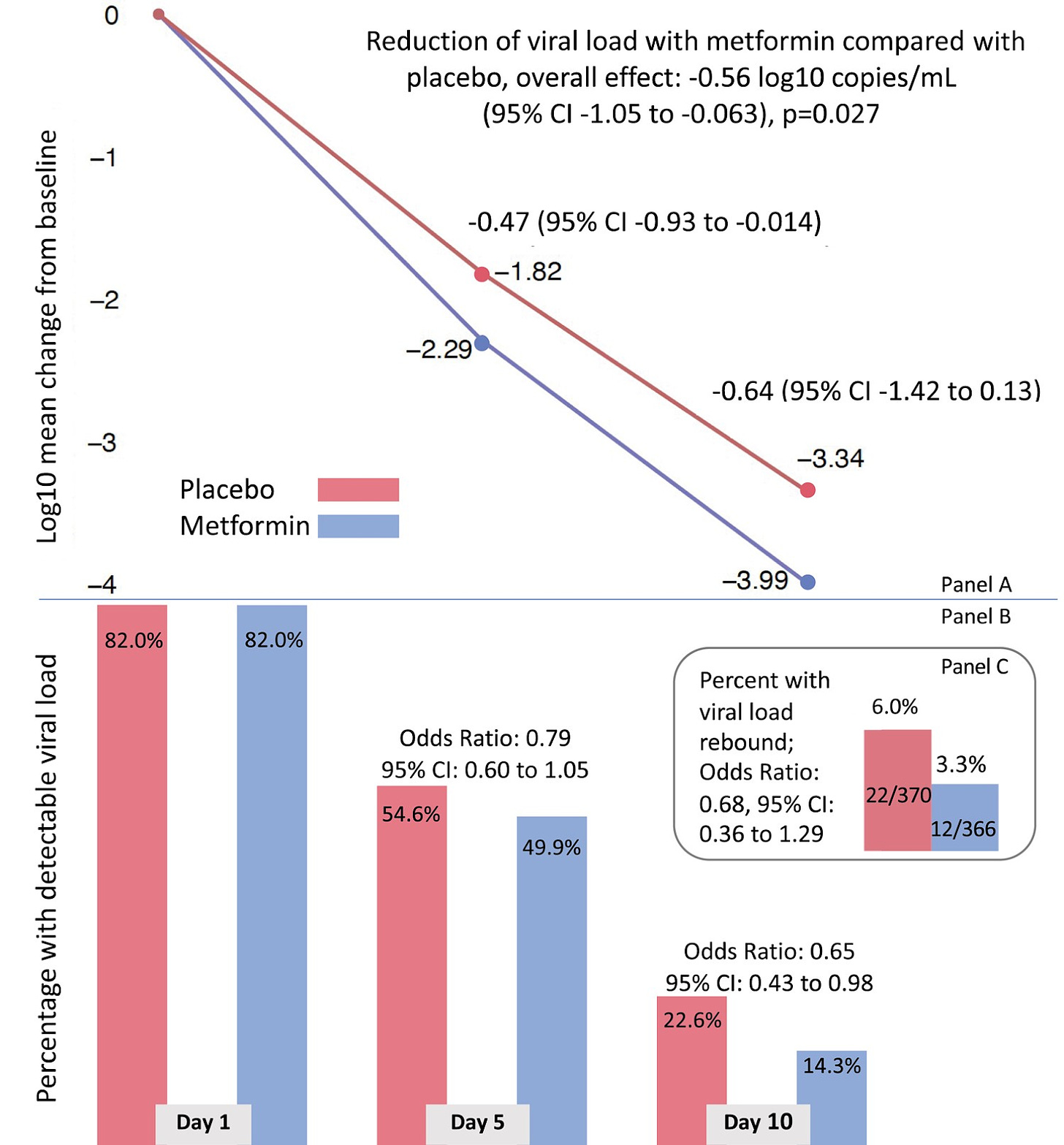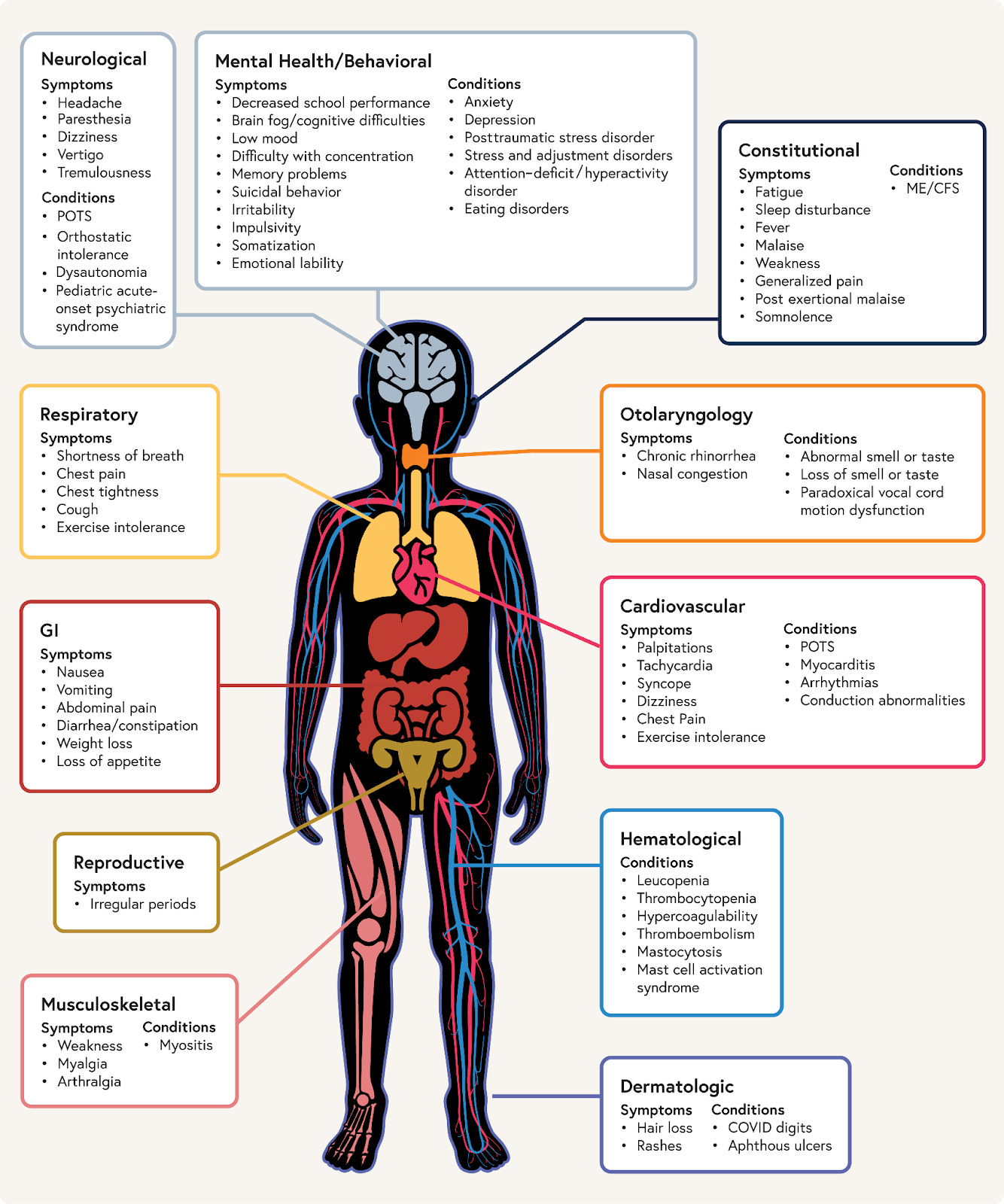Like last week nationally, SARS-CoV-2 is at “MINIMAL” levels across most of the U.S. Oklahoma and Hawaii have moderate levels of COVID in wastewater at this time. Palo Alto and San Jose are still at “MEDIUM” wastewater levels. Only about 1 in 205 people is currently infected with COVID in the United States as a whole. As of April 27 when last reported, hospitalizations were the lowest of the pandemic. England and Germany are seeing an uptick in wastewater COVID levels which is probably related to FLiRT variants like KP.2.
National SARS-CoV-2 data from Sara Anne Willette through May 7, 2024: https://iowacovid19tracker.org/
KP.2 is pushing out JN.1 and the JN.1 descendants and now represents 28.2% of cases in the U.S. When looking at national wastewater SCAN reports, we see that although SARS-CoV-2 levels are “LOW” nationally, Influenza A is noted as “HIGH”. Since flu season is over, this uptick may represent Avian Flu H5N1 which is currently infecting some dairy cattle in several states. H5N1 is an Influenza A virus and it could be running off and ending up in wastewater measurements.
Acute COVID infections
In Yorkshire, England, rheumatologist Dr. McGonagle noticed an uptick of a very rare autoimmune disease called MDA5, autoantibody associated dermatomyositis, that was being seen in people who may have had a COVID infection. The patients had severe lung scarring, often with interstitial lung disease (ILD), often some had rheumatologic symptoms such as rashes, arthritis, muscle pain and the fatality rate was very high. Dr. McGonagle contacted Dr. Ghosh of UCSD and her team to see if they could use their BoNE (Boolean Network Explorer) to evaluate the data. Together, they discovered an entirely new COVID-related syndrome which they named MIP-C. MIP-C stands for MDA5-autoimmunity and Interstitial Pneumonitis Contemporaneous with COVID-19 and is pronounced "mipsy". Patients who showed the highest level of MDA5 response also showed high levels of interleukin-15.
Paxlovid has been used to help high risk outpatients reduce risks of hospitalization and death from COVID infection. A new retrospective cohort study of almost 39,000 people shows that for patients hospitalized for COVID, treatment with Paxlovid was associated with 38% lower inpatient death, 30% less congestive heart failure, 37% less atrial fibrillation, 29% decrease in coronary artery disease, 32% lower chronic pulmonary disease, 29% less acute respiratory distress syndrome (ARDS), 83% lower risk of interstitial lung disease, and 43% lower end-stage renal disease.
Although Paxlovid is indicated for high risk people, several studies have demonstrated that Paxlovid does not improve time to symptom resolution or hospitalization or death from COVID for average risk people. A randomized, placebo-controlled trial of outpatient treatment of SARS-CoV-2 in average risk people with a BMI of 25+ shows that Metformin significantly reduced SARS-CoV-2 viral load. The standard risk population studied were 30 years or older, had a BMI of 25+ and were not hospitalized for COVID infection. Metformin was found to reduce SARS-CoV-2 viral load by 3.6-fold by day 10. Those who took Metformin were more likely to have no detectable viral load by day 5 and day 10 of infection (odds ratio, 0.72). “Metformin reduced the odds of hospitalization or death through 28 days by 58%; emergency department visits, hospitalizations, and death through 14 days by 42%; and Long COVID through 10 months by 42%.” In addition, viral rebound was almost halved with Metformin (3.3%) versus placebo (5.9%).
Figure 1: Effect of metformin versus placebo on viral load over time
From https://academic.oup.com/cid/advance-article/doi/10.1093/cid/ciae159/7660393
The WHO system for tracking viral changes, variants of interest (VOIs) and variants of concern (VOCs) were discussed in a new article in Nature magazine. The article also discusses the unpredictability of viral evolution.
Pediatrics
There is a misconception that children do not get Long COVID. An eye-opening new study presented at the Pediatric Academic Societies meeting shows that children, teens and young adults can get Long COVID symptoms that are specific to their age group. Long COVID was found even in babies. Infants with prior COVID infection had general symptoms of poor appetite, sleep difficulties, and cough compared to non-infected babies. Pre-schoolers had those symptoms plus gastrointestinal symptoms and stuffy nose.
"School-age children, adolescents, and young adults with a history of a COVID-19 infection had many prolonged symptoms in common, including low energy; tiring after walking; headaches; body, muscle, and joint pains; lightheadedness or dizziness; trouble concentrating or focusing; and gastrointestinal symptoms, like nausea and vomiting.” School-age children were also noted to have new phobias and often refused to go to school. Teens had more panic attacks and claustrophobia than teens without a history of COVID infection. In addition to low energy, joint pain and trouble focusing, young adults suffered from chest pain and palpitations as well.
We need to realize that COVID infections are not benign in children. This comprehensive review of Long COVID in children and young adults was published in Pediatrics in February 2024.
From https://publications.aap.org/pediatrics/article/153/3/e2023062570/196606/Postacute-Sequelae-of-SARS-CoV-2-in-Children
A study from China shows that grandchildren have a positive influence on their grandparents. Teaching college students in China about the benefits of COVID vaccination boosters for older adults resulted in an increased number of their grandparents getting a COVID booster.
Long COVID
The “Unite to Fight” conference on Long COVID and on ME/CFS will take place next week on May 15 and May 16. There are many amazing speakers scheduled. Note: Conference times listed are in the Central Europe Time Zone (9 hours ahead of San Francisco).
This week, I included some educational resources for health care providers regarding Long COVID assessment and treatments in my notes below. I also included a link to a consensus article written by Mayo Clinic on diagnosis and management of ME/CFS that includes which blood tests to order and what treatments are available. One treatment for cognitive impairment or brain fog is low dose Naltrexone. A new small study shows how Naltrexone may be working. Like in ME/CFS, people with Long COVID also have Transient Receptor Potential Melastatin 3 (TRPM3) ion channel dysfunction in their Natural Killer (NK) immune cells. Naltrexone treatment restored TRPM3 function in NK cells in ME/CFS and in Long COVID.
The NIH will be starting four new trials for Long COVID. RECOVER-SLEEP will test modafinil, solriamfetol and melatonin. RECOVER-ENERGIZE will test exercise and pacing in Long COVID. People on Twitter asked why the NIH would study exercise therapy in people with Long COVID because exercise can cause muscle necrosis in these patients and can be very dangerous to people with Post-Exertional Malaise (PEM). The NIH posted a news release that "All participants in RECOVER-ENERGIZE trials will be screened for PEM. Participants who are identified as having PEM, via a validated PEM questionnaire, will not be included in this trial."
Countries around the world are finding that Long COVID is impacting inflation and their economies because many young people in their 20s, 30s, and 40s are disabled from Long COVID and can no longer work. Talking about therapies for Long COVID and associated diseases, Dr. Svetlana Blitshteyn tweeted this week that “it's cheaper for society to make these therapies [IVIG, SCIG, PLEX] affordable and accessible than to have millions of young chronically-ill and disabled people being out of work.”
The Harvard Business Review put out a new guide for managers on Long COVID and potential workplace accommodations. This week, I found this excellent resource on how to get disability for people with chronic illnesses such as ME/CFS and Long COVID.
In other news, Eric Topol wrote an interesting article entitled When Medical A.I. is Lifesaving about a randomized trial in real world medical practice using AI to evaluate cardiac arrhythmias. It showed that the AI-ECG alert led to reduced mortality.
NutraSweet (neotame) was found to damage important bacteria in the gut microbiome.
Compared to the general population, women physicians are more likely to experience miscarriage, infertility and pregnancy complications, although often they are unaware of these risks. The authors of a new study recommend family planning education and support for women doctors.
Non-COVID Infectious Disease news
The government announced that they will pay dairy farmers to “protect workers and cover costs incurred treating and testing sick cows [with H5N1 avian flu]…Producers may also receive payments for lost milk production on farms with confirmed bird flu cases.” Virologist and Immunologist Rick Bright tweeted that if there is a large amount of H5N1 virus in milk, the pasteurization process may need to be adjusted to inactivate it.
RFK Jr reported “severe brain fog” and “trouble retrieving words” from a brain-eating worm and from mercury poisoning caused by eating fish with high mercury levels. Three people got drug-resistant Mycobacterium abscessus infections from stem-cell injections in Mexico. Europe is seeing a 10-fold increase in whooping cough (pertussis) this year. Vaccination protects against whooping cough.
Have a good rest of your weekend,
Ruth Ann Crystal MD
















.jpg)
No comments:
Post a Comment